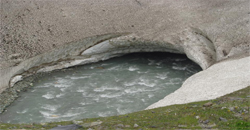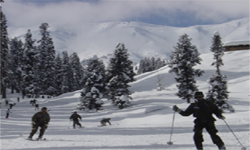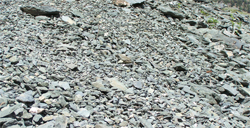Mountain Hazards
(vii) Snow Bridge. A bridge formed over a crevasse or a stream which is not very strong is always a hazard for people moving in snow bound areas. To avoid these bridges team should probe the route along which they are moving |
| |||||||||||||||
|
(viii) Snow on Trees. After fresh snow fall some snow gets accumulated on the trees which become hard after some days. This snow can cause harm if falls on somebody sitting under that tree. One should avoid camping under trees having snow accumulated on them | |||||||||||||||
(b) Weather Hazards. Weather conditions in the mountains may vary from one location to another as little as 10 km apart. Approaching storms may be hard to spot if masked by local peaks. A clear, sunny day in July could turn into a snowstorm in less than an hour. Always pack some sort of emergency gear. The types of weather hazards are enumerated below :- |
||||||||||||||||
(i) Wind Chill. Winds are stronger and more variable in mountains. The effect of low temperature is compounded by the heat extracting effect of the wind and the two in combination should be taken into account when considering the weather. | ||||||||||||||||
(c) Rock Hazards. Three types of rock hazards are as follows:- |
||||||||||||||||
(i) Scree or Loose Slate. Loose rock eroded from a mountain and found in steep slopes below cliffs. Can be very awkward to climb and descend over scree |
|
|||||||||||||||
| (ii) Verglas. Cold combined with fog can cause a thin sheet of ice to form on rocks is called verglas. Presence of verglas on rock face makes climb very dangerous. | ||||||||||||||||
| (iii) Loose Rocks. Loose rocks on the rock face make climb difficult as it becomes difficult to find natural anchors and to put pitons in the rock. Loose rocks are very dangerous for climbers following the lead climber. Avoid selecting route along the rock faces having loose rocks and everyone should wear helmet while climbing. | ||||||||||||||||
(d) Health Hazards. People operating in high altitudes and snow bound areas face following health problems:- |
||||||||||||||||
| (i) Hypothermia. It is generalized cooling of body caused by exposure to extreme cold. (ii) Chilblains. It is a cold injury which occurs due to excessive exposure of body parts to extreme cold. (iii) Frost Bite. It is caused by localized cooling of a body part. Tissue exposed to extreme cold can begin to freeze over time, often causing permanent damage (iv) High Altitude Pulmonary Oedema(HAPO). High altitude pulmonary Oedema is not a disease, it is an acute, dramatic and sometimes life-threatening condition seen in un-acclimatized persons. This sometimes happens suddenly and without warning to a person. (v) Acute Mountain Sickness(AMS). AMS is caused by diminished oxygen pressure in the atmosphere, and hence in the blood, and strikes those falling to adapt to high altitude. (vi) Snow Blindness. It occurs due to overexposure to sunrays and ultraviolet rays reflected from snow. (vii) Sun Burns. It occurs due to overexposure to sunrays, and ultraviolet rays over high mountains. Sun burn can be of two types ie superficial and deep |
||||||||||||||||
Conclusion 4. Lack of knowledge about mountains can be cause for mishaps and failure of operation. Therefore, it becomes imperative for a mountaineer to know all the problems he is likely to face while in mountains. |
||||||||||||||||
Training
The Jawahar Institute of Mountaineering and Winter Sports (JIM&WS).
Contact Us
The Jawahar Institute of Mountaineering and Winter Sports (JIM&WS)
Address: Nunwan Pahalgam (J&K)
Telephone: 01936-243129
01936-243129 (Training Section)
01936-243002 (PA to Principal)
9906967831 (Training Clerk)
9906967822 (Sub centre, Sanasar)
9906967821 (CPIO)
E-mail CPIO: principal@jawaharinstitutepahalgam.com
Fax:01936-243129
E-mail: principal@jawaharinstitutepahalgam.com
© Copyright JAWAHAR INSTITUTE OF
MOUNTAINEERING & WINTER SPORTS NUNWAN, PAHALGAM.Corporate Mail
Design, Development and Hosting of Website by Say Technologies












